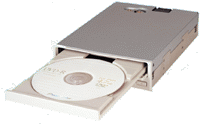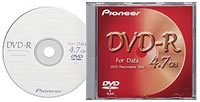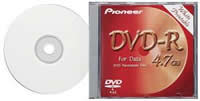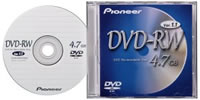Pioneer DVR-A03 DVD-R
1. Introduction
- Introduction:
 has
been a true "pioneer" in both the CD and DVD formats. Pioneer was
the first manufacturer that ever presented a CD-R writer and nowadays Pioneer
dominates the DVD recording with the successful DVR-S201 models. The need for
low priced DVD recorders has been something that many users were after, and
finally their dream came true with the arrival of the DVR-A03. The drive's price
(under 800$) makes it look tempting to potential DVD authors.
has
been a true "pioneer" in both the CD and DVD formats. Pioneer was
the first manufacturer that ever presented a CD-R writer and nowadays Pioneer
dominates the DVD recording with the successful DVR-S201 models. The need for
low priced DVD recorders has been something that many users were after, and
finally their dream came true with the arrival of the DVR-A03. The drive's price
(under 800$) makes it look tempting to potential DVD authors.
 Pioneer's
DVR-A03 was announced back in January of 2001 and its specifications made many
people quite happy. For the first time a drive could write and re-write
both CD/DVD formats! In Europe, the DVR-A03 was presented in Germany, on the
22nd of March 2001, only for G4 Mac Computers and in some Packard Bell/Compaq
PCs. Many people bought MAC computers at that time only to test the Pioneer
DVR-A03 drive.
Pioneer's
DVR-A03 was announced back in January of 2001 and its specifications made many
people quite happy. For the first time a drive could write and re-write
both CD/DVD formats! In Europe, the DVR-A03 was presented in Germany, on the
22nd of March 2001, only for G4 Mac Computers and in some Packard Bell/Compaq
PCs. Many people bought MAC computers at that time only to test the Pioneer
DVR-A03 drive.
Even nowadays the demand for the DVR-A03 is very high and in some countries you have to wait sometime before you will be able to buy it. Despite the fact that the drive's price is affordable, the DVD-R/W media prices are still high. Many users keep asking "Is this the drive we have all been waiting for?", "How does it perform?", "What is a DVD-R really?". Let's find out :-)
- The Hardware:
The drive supports almost all CD and DVD available formats (except HS-RW format):
|
Writing Speeds
|
Reading Speeds
|
| DVD-R: 2X-CLV (2.770
MB/s), 1X-CLV (1.385 MB/s) DVD-RW (both v1.0/1.1): 1X-CLV (1.385 MB/s) CD-R: 8X-CLV (1.20 MB/s), 4X-CLV (0.60 MB/s) CD-RW: 4X-CLV (0.60MB/s) |
DVD-ROM (Single): 4-CAV (5.540
MB/s) DVD-ROM (Dual): 2X-CLV (2.770 MB/s) DVD-R, DVD-RW: 2X-CLV (2.770 MB/s) CD-ROM : Max. 24X-CAV (3.60MB/s) CD-R,CD-RW: Max. 16X-CAV (2.40MB/s) CD-Audio: Max. 10X-CAV (1.50MB/s) Video-CD: 4X-CLV (0.60MB/s) |
 In
short, the drive supports 8x writing (CD), 4x re-writing (CD), 24x reading (CD),
1x/2x writing (DVD), 1x re-writing (DVD), and 4x reading (DVD). The drive's
buffer is 2MB and doesn't include any anti-buffer underrun protection for both
CD/DVD format. Note that in DVD-R format only DAO and packet writing recording
modes are supported. Also there are no subchannel data, overburning and RAW
writing...
In
short, the drive supports 8x writing (CD), 4x re-writing (CD), 24x reading (CD),
1x/2x writing (DVD), 1x re-writing (DVD), and 4x reading (DVD). The drive's
buffer is 2MB and doesn't include any anti-buffer underrun protection for both
CD/DVD format. Note that in DVD-R format only DAO and packet writing recording
modes are supported. Also there are no subchannel data, overburning and RAW
writing...
- The Usage:
The DVR-A03 can be used in many ways as Pioneer suggests:
 -
Add video to make dynamic image mixed presentations and demonstrations
-
Add video to make dynamic image mixed presentations and demonstrations
- Record the growth and development of your children from year to year
- Make archives of your personal video collection
- Backup large data volumes
- Digital photography
The most interesting aspect would be to author your own DVD collections and backup large volumes of important data. The 4.7GB of data can hold enough data to free your HD space :-)
- The Media:
The Pioneer DVR-A03 can write DVD-R, DVD-RW, CD-R and CD-RW media. There are 2 types of DVD-R media:
a) DVD-R for Authoring
b) DVD-R for General Use
 The
"DVD-R for Authoring" media can be recorded only with the Pioneer
DVR-S201/S101 (3.95 GB only) and the "DVD-R for General media" can
be recorded only with the Pioneer DVR-A03/DVR-103 (OEM) drives.
The
"DVD-R for Authoring" media can be recorded only with the Pioneer
DVR-S201/S101 (3.95 GB only) and the "DVD-R for General media" can
be recorded only with the Pioneer DVR-A03/DVR-103 (OEM) drives.
DVD-R Authoring drives use a 635 nm laser and specially designed DVD-R Authoring media. Unlike DVD-R General, the drive will write any content to DVD-R Authoring media. DVD-R General drives, which use a 650 nm laser and DVD-R General media, will only write content to DVD-R General media that has no copy restrictions and content that allows one copy. While both authoring and general media can be read by nearly all DVD drives - DVD-ROM, DVD-Video, DVD-RW, DVD-RAM and DVD-Video; - technical differences make it impossible to write to DVD-R authoring media using a general DVD-R system.
To make a large speech small, the Pioneer DVR-A03 will write only DVD-R media for General use (4.7GB) and not the DVD-R for Authoring (3.9/4.7GB). The drive can, of course, read written DVD-R for Authoring media.
 Prices
of the media in retail market are around $15, making them quite expensive for
the normal user. Prices are soon expected to drop, since more and more manufacturers
will start producing DVD-R media and drives will become more popular. Currently
the following manufacturers ships DVD-R/W media:
Prices
of the media in retail market are around $15, making them quite expensive for
the normal user. Prices are soon expected to drop, since more and more manufacturers
will start producing DVD-R media and drives will become more popular. Currently
the following manufacturers ships DVD-R/W media:
|
Manufacturer
|
Category
|
Model Number
|
|
JVC
|
DVD-RW
|
VD-RW120
|
|
Fuji Photo Film
|
DVD-RW
|
DVD-RW4.7A
|
|
Hitachi Maxell
|
DVD-RW
|
DRW-V47.1P
|
|
DVD-R
|
DR-V47.1P
|
|
|
Mitsubishi Chemical
|
DVD-RW
|
DRR4G7S1P
|
|
DVD-RW
|
DRW47V1
|
|
|
DVD-R
|
DRR47V1
|
|
|
Pioneer Video
|
DVD-RW
|
DVS-RW47
|
|
DVD-RW
|
DVS-RW47A
|
|
|
DVD-R
|
DVS-R47
|
|
|
TDK
|
DVD-DW
|
DVD-RW47VN
|
|
DVD-R
|
DVD-R120VN
|
There is also DVD-R printable media in case you need them. CD-R printers like Signature III can print them without any problems. There is a catch here that you should be aware of: "Both the DVD-R/RW cannot hold 4.7GB in reality!!!"
 Pioneer
provides this answer: "...DVD capacities are expressed
in billion byte quantities. For example a single layer DVD holds 4.7 billion
bytes (G bytes), not 4.7 gigabytes (GB). It only holds 4.37 gigabytes. A gigabyte
is normally accepted in the computer world to mean 1024 x 1024 x 1024 bytes,
or about 1.07 billion bytes. However in the real world normally "giga"
represents multiples of 1000. DVD-R and DVD-RW media will hold precisely 4.7
billion bytes. This 7% difference between 4.7 and 4.37 has created a lot of
confusion, because people will complain that they can't get a 4.65 gigabyte
disc image to fit onto a 4.7 billion byte disc. This is very true, albeit confusing
due to the lack of standards in specifying capacities of digital storage devices.
DVD-R/RW writing software may report the available disc space of a newly erased
DVD-RW as 4.489GB but it is in fact 4.37GB. So you need to keep your total project
file size to less than 4.37GB..."
Pioneer
provides this answer: "...DVD capacities are expressed
in billion byte quantities. For example a single layer DVD holds 4.7 billion
bytes (G bytes), not 4.7 gigabytes (GB). It only holds 4.37 gigabytes. A gigabyte
is normally accepted in the computer world to mean 1024 x 1024 x 1024 bytes,
or about 1.07 billion bytes. However in the real world normally "giga"
represents multiples of 1000. DVD-R and DVD-RW media will hold precisely 4.7
billion bytes. This 7% difference between 4.7 and 4.37 has created a lot of
confusion, because people will complain that they can't get a 4.65 gigabyte
disc image to fit onto a 4.7 billion byte disc. This is very true, albeit confusing
due to the lack of standards in specifying capacities of digital storage devices.
DVD-R/RW writing software may report the available disc space of a newly erased
DVD-RW as 4.489GB but it is in fact 4.37GB. So you need to keep your total project
file size to less than 4.37GB..."
Here is what Windows Explorer says about Pioneer's DVD-R media:

In case you are dreaming more capacity than 4.7GB, Pioneer says: "...There are no plans for Dual layer DVD-R media. Also dual sided discs would require a caddie, making handling and ROM drive compatibility difficult. Currently there are no plans to make dual sided media, however Changer uses are under consideration...". To tell you the truth, we did see dual side DVD-R media from Mitsui at the Cebit 2001 show ;-)
 As
we said earlier the drive can also write DVD-RW format (for General v1.0/v1.1
discs). The initial version 1.0 DVD-RW media (released only in Japan in late
1999) included a pre-obscured or embossed area of each disc to ensure that decryption
keys used to protect motion picture content cannot be recorded. This embossed
area is unreadable by nearly all video players and ROM drives. The next version
of DVD-RW, version 1.1, included a readable embossed area so that playback compatibility
can be maximized while still protecting against unauthorized recording. Both
DVD-R/W media have a visible circle near the inner of the disc, which represents
the written CSS protection theme for maximizing media compatibility with newer
DVD players. DVD-RW media can support more than 1,000 rewrite cycles without
signal degradation. Packet writing also applies in DVD-RW format.
As
we said earlier the drive can also write DVD-RW format (for General v1.0/v1.1
discs). The initial version 1.0 DVD-RW media (released only in Japan in late
1999) included a pre-obscured or embossed area of each disc to ensure that decryption
keys used to protect motion picture content cannot be recorded. This embossed
area is unreadable by nearly all video players and ROM drives. The next version
of DVD-RW, version 1.1, included a readable embossed area so that playback compatibility
can be maximized while still protecting against unauthorized recording. Both
DVD-R/W media have a visible circle near the inner of the disc, which represents
the written CSS protection theme for maximizing media compatibility with newer
DVD players. DVD-RW media can support more than 1,000 rewrite cycles without
signal degradation. Packet writing also applies in DVD-RW format.













